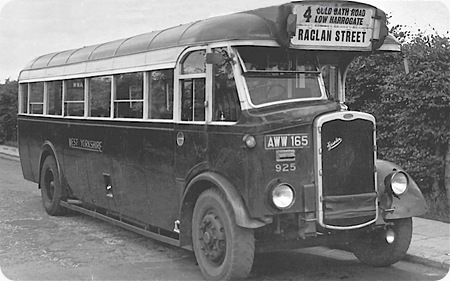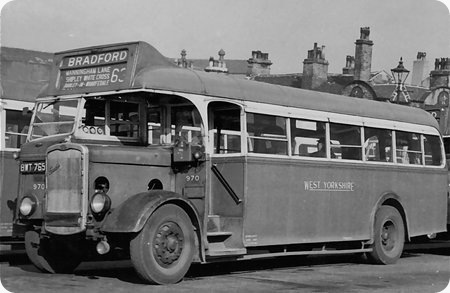West Yorkshire - Bristol JO5G - AWW 165 - 925

Photograph by ‘unknown’ if you took this photo please go to the copyright page.
West Yorkshire Road Car Company
1936
Bristol JO5G
ECOC B32F
Bristol JO5G 925 is seen operating on a local service in Harrogate about 1950. This bus was one of
sixty built by the Eastern Counties Omnibus Company in 1935/36 and is of the square back style. The
previous posting of West Yorkshire JO5G 970 shows the round back style body of the 1937 batch. 925 was
in service up to August 1952 and all the square back “Js” had gone by the end of October 1952.
Harrogate was also the headquarters for the West Yorkshire Road Car Company and mecca for the bus
enthusiast. It always seemed to me to be a place of bus contrasts with the oldest in the fleet usually
on the town local services and the newest buses generally operating on the prestigious 36 Leeds to Ripon
service. Perhaps this was West Yorkshire trying to impress their United cousins at Ripon.
I made
many visits to Harrogate in the fifties using the WY Skipton to Harrogate 76 service from
Burley-in-Wharfedale and well remember my first sighting of the prototype Bristol Lodekka 822 (DX1) as
well as the pre-production Lodekka with an open platform and later numbered DX2. Other strange buses to
seen in Harrogate were the Morris/Beadles 618/619 (SM1/SM2) on town local services but my favourites
were the many Bristol JO5Gs to be seen on various routes. These were very exciting days for a young bus
enthusiast and never to be forgotten.
Photograph and Copy contributed by Richard Fieldhouse
———
24/04/11 - 15:04
The photo of 925 is nostalgic beyond belief for me as I so well remember these
earlier "J"s in Bradford’s Chester Street Bus Station when I was a boy. They were
obviously older buses than the "rounder" BWT Js and the following L types with similar
bodies. There was always one parked (in my memory anyway!) on the little adjacent piece of land on
the right as one exited the bus station, and it always seemed to have the "Have you Macleaned
your teeth today" advert on the back. Other memories of these wonderful machines were on trips
to Baildon, and to Dick Hudsons on the Bingley to Eldwick service. Oh to be able to ride on one
again! They were amongst the most characterful and attractive buses of all time. Wonderfully
efficient buses too, from an operational viewpoint.
Thank you to Richard for this superb
memory jogger.
It may be of interest to other enthusiasts to know that I am currently
preparing a readable WY fleet list from info. taken from various publications Hopefully, this will
be included in the fleet list section on this website.
John Whitaker
———
24/04/11 - 15:06
My sentiments exactly Richard. From 1941 - 1947 I travelled to and from Ben
Rhydding School on the Bristol Js, prewar Ls, Dennis Aces and Lancets.
The two "square
backed" ones allocated to Ilkley at the time were 946/7 AWX 798/9 and I loved them. Later, when
I was a conductor at Ilkley from 1960 my favourite route was the 76 Skipton - Tadcaster. It was a
five hour round trip (wonderful) and took five "cars" to operate it - it was shared by
Harrogate, Ilkley, Skipton and Wetherby depots (and by GRASSINGTON who used the Skipton depot
"car" for one round trip.) I too loved the atmosphere of Harrogate and you always had the
feeling that the Company’s excellence was concentrated there - indeed anyone who had to go there on
a disciplinary charge (as opposed to local depot action) knew full well that they might come back
via the Labour Exchange. If you were travelling from Burley in 1960/1 I may well have issued you
with a ticket or two !!
Chris Youhill
Quick links to the - Comments Page - Contact Page - Home Page

